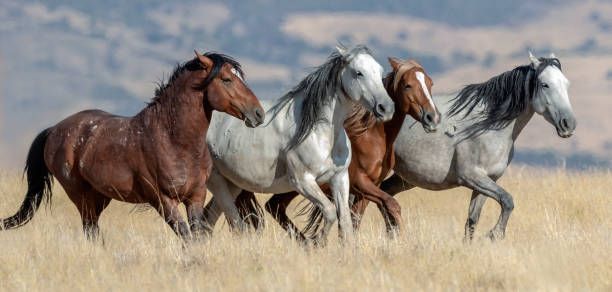History:
Mustang horses have a long and illustrious history in North America. They are believed to have descended from horses brought over by Spanish explorers and settlers in the 16th century. Over time, these horses adapted to the harsh conditions of the American West, becoming hardier and more independent. Mustangs had an integral role in the settling of the West, helping settlers with transportation and labor. The mustang was also an important symbol for Native American tribes who adopted the horses for their own uses.
Appearance:

Mustangs vary in size and color, but generally have a sturdy build and a stocky frame. They usually have a strong and muscular neck and a broad forehead. Mustangs have a thick mane and tail, and often have a long, shaggy winter coat. Common colors for mustangs include dun, bay, black, chestnut, and roan.
Personality Traits
Mustang horses are loyal and devoted to their owners and are known for their strong bond with humans. They are also known for their intelligence, as they can easily learn new tricks and behaviors.
Intelligence: Mustangs are also very intelligent and have the ability to think and problem-solve. They can be trained to do a variety of tasks, including herding and carrying a rider.
Care and Health:
Mustangs require a diet that is high in fiber, as well as plenty of exercise. They should be fed a mixture of hay, grains, and minerals. Exercise should include activities such as lunging, trail riding, and groundwork.
Health Care: Mustangs should be checked regularly for any signs of illness or injury, and should receive routine vaccinations and deworming. Farrier care is also important for mustangs, as is regular grooming to keep the coat and hooves in good condition.
Mustang Breeding:
Herd Groups: Mustangs live in herd groups, which are led by a dominant mare. The mares form strong bonds with their foals, and the herd is very protective of its members.
Also Read: Icelandic Horse
Genetics: Mustangs have a unique genetic makeup, which has allowed them to adapt to the harsh conditions of the American West. This genetic diversity is important for the conservation of the mustang species.
Mustangs in Sports:
Racing: Mustang racing is a popular competition in which mustangs compete against each other over a set distance. Races can be open to any mustang, or restricted to certain breeds or ages.

Showing: Mustang showing is another popular competition in which mustangs are judged on their conformation, movement, and performance. Classes may also include showmanship, trail riding, and other demonstrations.
Pros and Cons of owning a Mustang:
A. Pros: Mustangs make wonderful companions, as they are loyal, intelligent, and easy to train. They are also hardy and can adapt to a variety of environments. Owning a mustang can also be rewarding, as they can be trained to do a variety of tasks, such as carrying a rider or performing in competitions.
B. Cons: Mustangs are not for everyone, as they can be difficult to handle and require a lot of patience and dedication. They are also more prone to injury due to their hardy nature, and require regular veterinary and farrier care.
Where to buy:
Mustangs can be adopted through the Bureau of Land Management (BLM), which manages wild horses and burro herds on public land. Mustangs can also be found at rescues, sanctuaries, and other organizations that specialize in mustang adoption.

The adoption process for mustangs can vary depending on the organization or individual. Generally, adopters must fill out an application and provide proof of adequate facilities for the horse. The BLM also requires adopters to attend an adoption clinic to learn about mustang care and training.
Conclusion:
Mustangs are a unique and enduring breed that has a long and storied history in North America. They are loyal, intelligent, and hardy, making them ideal companions for experienced horse owners. Mustangs require a lot of care and dedication, but the rewards of owning one are numerous.
FAQ:
Q: What is the average size of a mustang?
A: Mustangs range in size from 13 to 15 hands (52 to 60 inches) tall and weigh between 800 and 1,000 pounds.
Q: What are some of the common colors for mustangs?
A: Common colors for mustangs include dun, bay, black, chestnut, and roan.
Q: What type of diet do mustangs require?
A: Mustangs require a diet that is high in fiber, as well as plenty of exercise. They should be fed a mixture of hay, grains, and minerals.
























